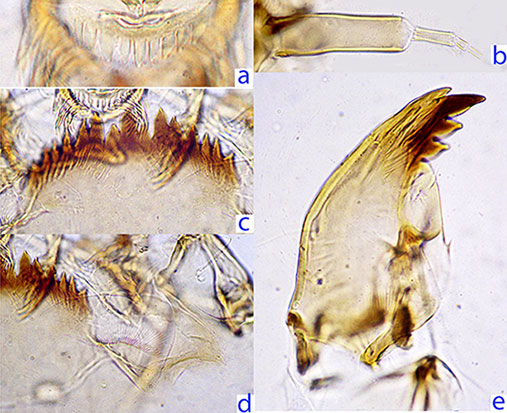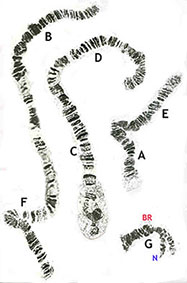Chironomus species PK6
Probably another member of the C. flaviplumus group.
Adult and Pupa not currently known.
Fourth instar larva: A small-medium plumosus-type. Head capsule with gular region and fronto-clypeus pale. Salivarium about 84 x 20 µm, 4.13 times longer than deep.
Mentum (Fig. c, below) width abt. 0.5-0.6 of VHL; 4th lateral reduced slightly (Ty. I-ii), center tooth probably Ty. III. Ventromental plates (Fig. d, below) about 190-195 µm wide, separated by about 0.35 of the mentum width, 3.41-3.85 times wider than deep and 1.07 times the mentum width; with 41 (40-43) striae, VMR about 0.38.
Pecten epipharyngis (Fig. a, below) with 10-14 teeth of type B. Premandible with inner tooth about 4.5 times wider than the outer tooth, both coming to relatively sharp points (type B1).
Antennal segments (Fig. b, below) (micron): 105 : 31.5 : 10 : 12.5 : 8. A1 about 1/3 of VHL and 2.8-3.3 times longer than wide; RO about 0.36-0.45 up from base of segment. AR 1.59-1.78.
Distance between the antennal bases greater than that between the S4 setae, which are separated by 77-82% of the FC width at that point.
Mandible (Fig. e, below) abt. 238-243 µm long, 3rd inner tooth only partly separated and not darkened (I-IIA); about 14-16 furrows on outer surface at the base; 10-11 taeniae in Pecten mandibularis; Mdt-Mat 23-25, MTR 0.26-0.34.

Cytology: Four polytene chromosomes with the pseudothummi-cytocomplex combination BF, CD, AE, G.
Nucleolus terminal on arm G, which may be unpaired in this region. Arm G also with two well developed BRs, one median, the other distal.
Polymorphism in arms A and C.
Arm A1: 1 - 2c, 11 - 7, 12, 3 - 2d, 6 - 4, 13 - 19 as A1 of species SS
Arm A2: Inversion of approx distal half of arm, bringing " olive" near distal end
Arm B1: Puff about 1/3 from centromere, with dark bands distal as sp.SS
Arm C1: As species SS and large inv. c.f. striatipennis
Arm C2: Inversion of about a quarter of the arm near distal end (broken).
Arm D1: Differs by simple inversion from species SS
Arm E1: 1 - 2c, 8b - 6, 3 - 2d, 8 - 9, 4 - 5, 12a - 10, 12b - 13 inv3d-12b from luridus, etc
Arm F1: Inverted c.f. species SS?
 Chromosome complement of C. sp. PK6 heterozygous C1/C2
Chromosome complement of C. sp. PK6 heterozygous C1/C2
Found: India: Jammu - Kabeer colony (32.70°N, 75.00°E), Deoli Village (32.70°N, 75.00°E).
Jammu; & Kashmir - Indira Nagar (32.07°N, 74.83°E)
Pakistan (BOLD).
This species is close to, but not identical with, the Chironomus species (C. sp. SS) of Sumitra Saxena (1995).
DNA Sequence
DNA BARCODE suggests it is probably another member of the C. flaviplumus-group.
Probable conspecific specimen in BOLD cannot be accessed for Bin number or collection locality.
[ Return to Index
| Go to References ]
|

 Chromosome complement of C. sp. PK6 heterozygous C1/C2
Chromosome complement of C. sp. PK6 heterozygous C1/C2